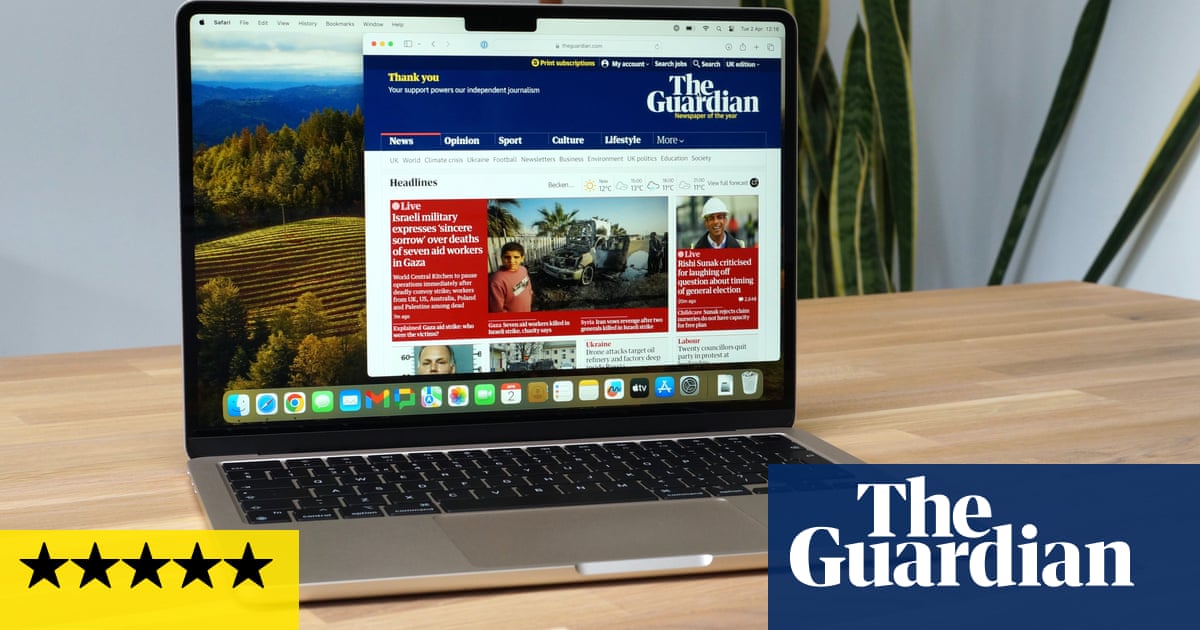Apple’s latest MacBook Air adds more power to an already potent package while maintaining its very long battery life and coming at a lower price than its predecessor.
The 2024 model ships with Apple’s latest M3 chip, first seen in the MacBook Pro, giving the company’s thinnest and lightest machine a boost in performance. On the outside the laptop is identical to the 2022 model.
It now starts at £1,099 (€1,299/$1,099/A$1,799), a welcome £150 price cut in the UK, though it is still firmly in the premium category. It sits above the M2 MacBook Air, which is still on sale at a reduced £999.
Apple hasn’t tried to reinvent the wheel, avoiding the frequently fancy folding forms of rivals, focusing instead on perfecting the standard laptop form. The slim aluminium frame, 13.6in LCD screen, excellent keyboard and large trackpad are all top notch. The four speakers hidden in the deck top most rivals, while the 1080p webcam and great mics make video chats a breeze.
The M3 chip means it has far more power and much longer battery life than most compact laptops. The M3 chip is about 18% faster than the M2 and considerably faster than Intel-based Macs or PC laptops from a few years ago.
Note that the base model has only 8GB of memory. While it is certainly snappy now, and macOS 14 does a good job at handling memory constraints, 8GB is likely to end up being a bit meagre as the years go by. Doubling it to 16GB costs an extra £200 (€230/$200/A$300).
The battery life regularly exceeds 16 hours of work between charges, including several hours of photo editing in Affinity Photo, lots of browsing and web apps in Chrome, plus Evernote and a variety of smaller tools.
It took more than two hours to fully charge the Air with the included 30W charger and MagSafe cable, hitting 50% in about an hour, but it can fast-charge to 50% in about 30 minutes with a 70W or higher-power adaptor if you have one.
Specifications
-
Screen: 13.6in LCD (2560×1600; 224 ppi) True Tone
-
Processor: Apple M3 with eight or 10-core GPU
-
RAM: 8, 16 or 24GB
-
Storage: 256GB, 512GB, 1TB or 2TB SSD
-
Operating system: macOS 14 Sonoma
-
Camera: 1080p FaceTime HD
-
Connectivity: wifi 6E, Bluetooth 5.3, 2x USB 4, headphones
-
Dimensions: 215 x 304.1 x 11.3mm
-
Weight: 1.24kg
Sustainability
The MacBook Air is made with 50% recycled materials including aluminium, cobalt, copper, glass, gold, steel, tin, rare earth elements and plastic. Apple breaks down the computer’s environmental impact in its report.
The computer is generally repairable and the battery can be replaced for £159 by Apple. Repair specialists iFixit gave the machine five out of 10 for repairability. Apple offers trade-in and free recycling schemes, including for non-Apple products.
Price
The Apple 13in MacBook Air starts at £1,099 (€1,299/$1,099/A$1,799) with an 8-core GPU, 8GB of RAM and 256GB of storage. 15in versions start at £1,299 (€1,599/$1,299/A$2,199).
For comparison, the M2 13in MacBook Air costs £999, M3 MacBook Pro starts at £1,699, the Framework Laptop 13 starts at £1,049, Microsoft Surface Laptop 5 starts at £999, and the Dell XPS starts at £1,198.99.
Verdict
The MacBook Air remains the thin and light notebook to beat, now with more power thanks to the M3 chip.
The keyboard, trackpad and body are still best in class, with a great screen, good speakers and a solid webcam, Apple nails the bits you interact with every day, making the Air feel truly premium.
The laptop silently sails through daily tasks and takes on more demanding workloads with aplomb, though it is worth considering doubling the base 8GB of memory.
It is the class-leading battery life that really sets the Air apart, essentially doubling the useful working time of most rivals. You simply won’t need to carry a charger with you.
If you are looking for a premium, everyday laptop and do not need Windows, the MacBook Air should be on your list in either the 13in or 15in flavour.
Pros: super-fast M3 chip, silent and cool running, extremely long battery life, great 13.6in screen, great keyboard, best-in-class trackpad, MagSafe, good speakers, good mics and webcam, lots of recycled materials, Touch ID.
Cons: only two USB-C ports and no USB-A or SD card slot, no Centre Stage camera or Face ID, low starting memory and expensive upgrades.







